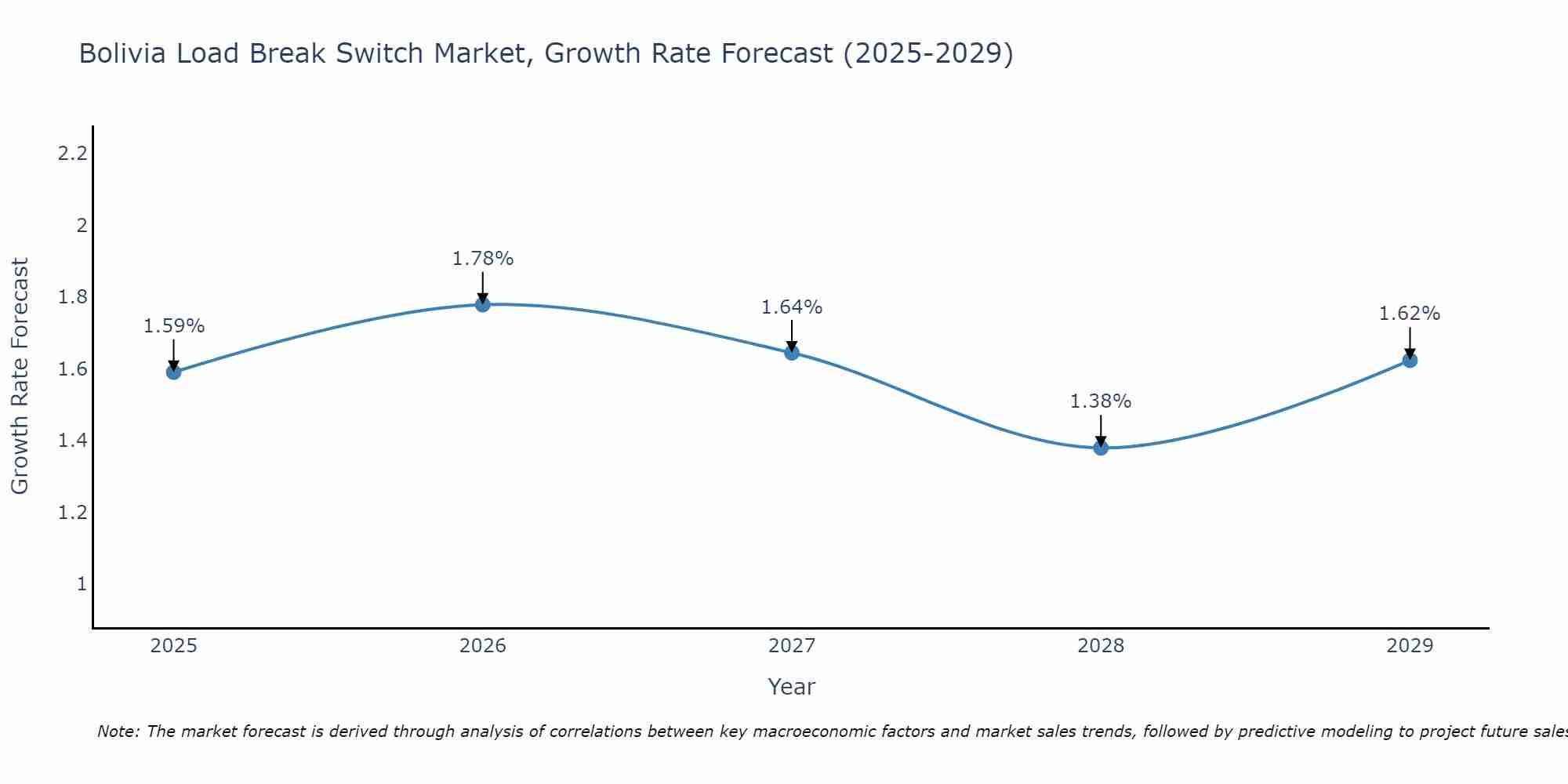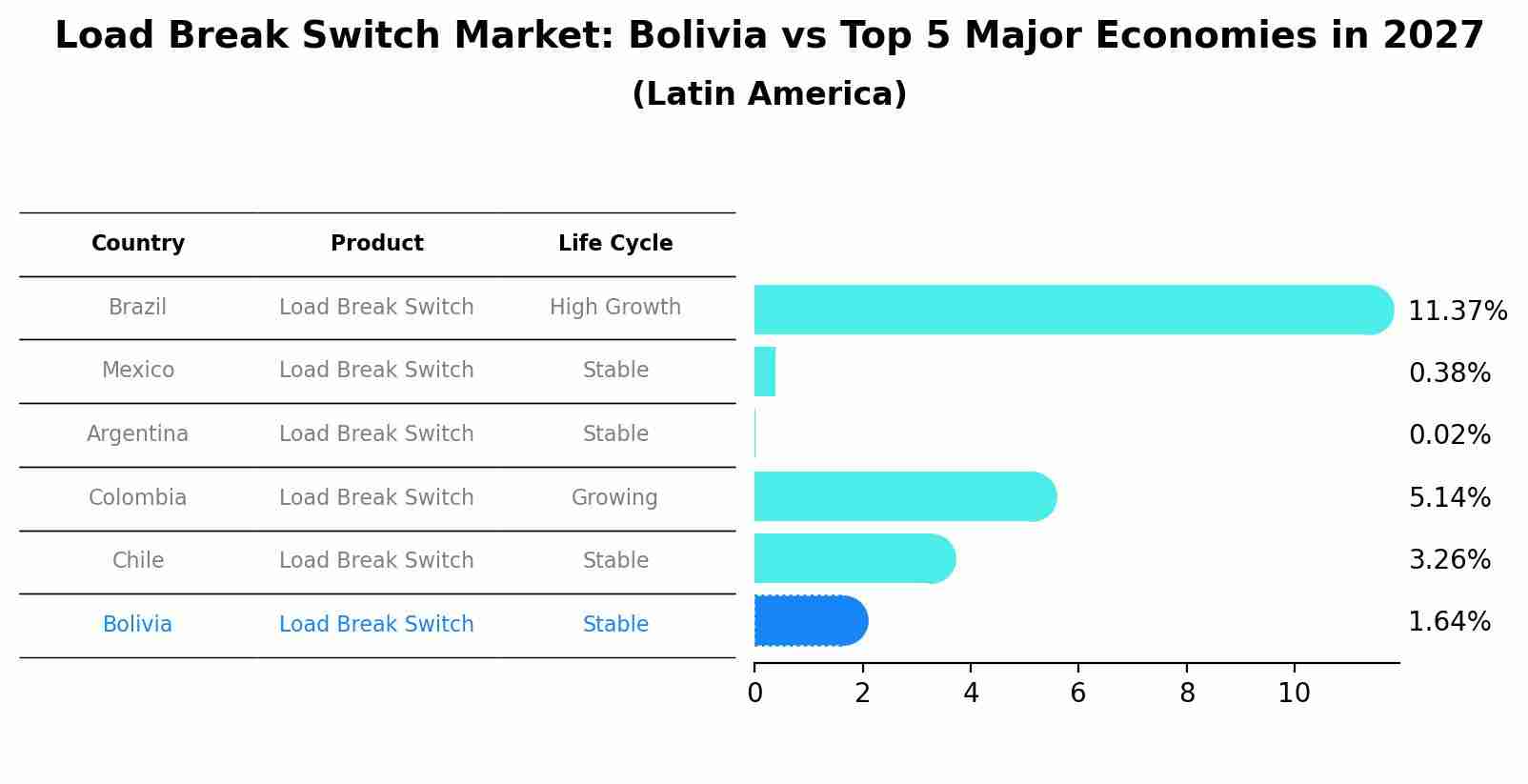Bolivia Load Break Switch Market (2025-2031) | Outlook, Value, Segmentation, Forecast, Analysis, Trends, Size, Companies, Growth, Industry, Revenue & Share
| Product Code: ETC5128221 | Publication Date: Nov 2023 | Updated Date: Sep 2025 | Product Type: Market Research Report | |
| Publisher: 6Wresearch | Author: Bhawna Singh | No. of Pages: 60 | No. of Figures: 30 | No. of Tables: 5 |
Bolivia Load Break Switch Market Size Growth Rate
The Bolivia Load Break Switch Market is projected to witness mixed growth rate patterns during 2025 to 2029. Growth accelerates to 1.78% in 2026, following an initial rate of 1.59%, before easing to 1.62% at the end of the period.

Load Break Switch Market: Bolivia vs Top 5 Major Economies in 2027 (Latin America)
The Load Break Switch market in Bolivia is projected to grow at a stable growth rate of 1.64% by 2027, highlighting the country's increasing focus on advanced technologies within the Latin America region, where Brazil holds the dominant position, followed closely by Mexico, Argentina, Colombia and Chile, shaping overall regional demand.

Bolivia Load Break Switch Market Overview
The Bolivia load break switch market is influenced by the need for reliable electrical switching solutions in power distribution systems. Load break switches are essential for safely isolating electrical circuits and protecting equipment from overloads. The market is growing due to infrastructure development and increasing demand for reliable electrical systems. Challenges include the high cost of advanced switching equipment and the need for regular maintenance.
Drivers of the market
The Bolivia Load Break Switch Market is driven by the increasing demand for reliable and efficient electrical distribution systems. The need for improved grid infrastructure and the integration of renewable energy sources into the power grid are key factors propelling the market. Additionally, the government`s focus on modernizing the electrical network and enhancing grid stability in Bolivia contributes to the growing adoption of load break switches.
Challenges of the market
Bolivia`s load break switch market encounters challenges related to the slow pace of industrial development and the limited adoption of modern electrical infrastructure. High import costs for advanced switchgear components and the lack of local manufacturing capabilities also pose significant barriers. Additionally, the market is affected by the fluctuating demand from the power distribution sector.
Government Policy of the market
In Bolivia, the government regulates the load break switch market through policies that ensure the reliability and safety of electrical equipment. Standards and certification requirements are enforced to ensure that load break switches meet national and international safety standards. The government also supports the modernization of the electrical grid, encouraging the adoption of advanced load break switch technologies to enhance grid stability and efficiency.
Key Highlights of the Report:
- Bolivia Load Break Switch Market Outlook
- Market Size of Bolivia Load Break Switch Market, 2024
- Forecast of Bolivia Load Break Switch Market, 2031
- Historical Data and Forecast of Bolivia Load Break Switch Revenues & Volume for the Period 2021-2031
- Bolivia Load Break Switch Market Trend Evolution
- Bolivia Load Break Switch Market Drivers and Challenges
- Bolivia Load Break Switch Price Trends
- Bolivia Load Break Switch Porter`s Five Forces
- Bolivia Load Break Switch Industry Life Cycle
- Historical Data and Forecast of Bolivia Load Break Switch Market Revenues & Volume By Type for the Period 2021-2031
- Historical Data and Forecast of Bolivia Load Break Switch Market Revenues & Volume By Gas-Insulated for the Period 2021-2031
- Historical Data and Forecast of Bolivia Load Break Switch Market Revenues & Volume By Air-Insulated for the Period 2021-2031
- Historical Data and Forecast of Bolivia Load Break Switch Market Revenues & Volume By Others for the Period 2021-2031
- Historical Data and Forecast of Bolivia Load Break Switch Market Revenues & Volume By Deployment for the Period 2021-2031
- Historical Data and Forecast of Bolivia Load Break Switch Market Revenues & Volume By Outdoor for the Period 2021-2031
- Historical Data and Forecast of Bolivia Load Break Switch Market Revenues & Volume By Indoor for the Period 2021-2031
- Historical Data and Forecast of Bolivia Load Break Switch Market Revenues & Volume By End-User for the Period 2021-2031
- Historical Data and Forecast of Bolivia Load Break Switch Market Revenues & Volume By Utilities for the Period 2021-2031
- Historical Data and Forecast of Bolivia Load Break Switch Market Revenues & Volume By Commercial for the Period 2021-2031
- Historical Data and Forecast of Bolivia Load Break Switch Market Revenues & Volume By Industrial for the Period 2021-2031
- Bolivia Load Break Switch Import Export Trade Statistics
- Market Opportunity Assessment By Type
- Market Opportunity Assessment By Deployment
- Market Opportunity Assessment By End-User
- Bolivia Load Break Switch Top Companies Market Share
- Bolivia Load Break Switch Competitive Benchmarking By Technical and Operational Parameters
- Bolivia Load Break Switch Company Profiles
- Bolivia Load Break Switch Key Strategic Recommendations
Frequently Asked Questions About the Market Study (FAQs):
1 Executive Summary |
2 Introduction |
2.1 Key Highlights of the Report |
2.2 Report Description |
2.3 Market Scope & Segmentation |
2.4 Research Methodology |
2.5 Assumptions |
3 Bolivia Load Break Switch Market Overview |
3.1 Bolivia Country Macro Economic Indicators |
3.2 Bolivia Load Break Switch Market Revenues & Volume, 2021 & 2031F |
3.3 Bolivia Load Break Switch Market - Industry Life Cycle |
3.4 Bolivia Load Break Switch Market - Porter's Five Forces |
3.5 Bolivia Load Break Switch Market Revenues & Volume Share, By Type, 2021 & 2031F |
3.6 Bolivia Load Break Switch Market Revenues & Volume Share, By Deployment, 2021 & 2031F |
3.7 Bolivia Load Break Switch Market Revenues & Volume Share, By End-User, 2021 & 2031F |
4 Bolivia Load Break Switch Market Dynamics |
4.1 Impact Analysis |
4.2 Market Drivers |
4.2.1 Increasing investments in infrastructure projects in Bolivia |
4.2.2 Growing urbanization and industrialization leading to higher demand for electricity |
4.2.3 Government initiatives to improve electricity access and reliability |
4.3 Market Restraints |
4.3.1 Economic instability and political uncertainties in Bolivia |
4.3.2 High initial investment cost for load break switches |
4.3.3 Lack of skilled labor for installation and maintenance of load break switches |
5 Bolivia Load Break Switch Market Trends |
6 Bolivia Load Break Switch Market Segmentations |
6.1 Bolivia Load Break Switch Market, By Type |
6.1.1 Overview and Analysis |
6.1.2 Bolivia Load Break Switch Market Revenues & Volume, By Gas-Insulated, 2021-2031F |
6.1.3 Bolivia Load Break Switch Market Revenues & Volume, By Air-Insulated, 2021-2031F |
6.1.4 Bolivia Load Break Switch Market Revenues & Volume, By Others, 2021-2031F |
6.2 Bolivia Load Break Switch Market, By Deployment |
6.2.1 Overview and Analysis |
6.2.2 Bolivia Load Break Switch Market Revenues & Volume, By Outdoor, 2021-2031F |
6.2.3 Bolivia Load Break Switch Market Revenues & Volume, By Indoor, 2021-2031F |
6.3 Bolivia Load Break Switch Market, By End-User |
6.3.1 Overview and Analysis |
6.3.2 Bolivia Load Break Switch Market Revenues & Volume, By Utilities, 2021-2031F |
6.3.3 Bolivia Load Break Switch Market Revenues & Volume, By Commercial, 2021-2031F |
6.3.4 Bolivia Load Break Switch Market Revenues & Volume, By Industrial, 2021-2031F |
7 Bolivia Load Break Switch Market Import-Export Trade Statistics |
7.1 Bolivia Load Break Switch Market Export to Major Countries |
7.2 Bolivia Load Break Switch Market Imports from Major Countries |
8 Bolivia Load Break Switch Market Key Performance Indicators |
8.1 Percentage increase in infrastructure spending in Bolivia |
8.2 Growth rate of urban population and industrial sector |
8.3 Rate of adoption of renewable energy sources in the country |
9 Bolivia Load Break Switch Market - Opportunity Assessment |
9.1 Bolivia Load Break Switch Market Opportunity Assessment, By Type, 2021 & 2031F |
9.2 Bolivia Load Break Switch Market Opportunity Assessment, By Deployment, 2021 & 2031F |
9.3 Bolivia Load Break Switch Market Opportunity Assessment, By End-User, 2021 & 2031F |
10 Bolivia Load Break Switch Market - Competitive Landscape |
10.1 Bolivia Load Break Switch Market Revenue Share, By Companies, 2024 |
10.2 Bolivia Load Break Switch Market Competitive Benchmarking, By Operating and Technical Parameters |
11 Company Profiles |
12 Recommendations | 13 Disclaimer |
- Single User License$ 1,995
- Department License$ 2,400
- Site License$ 3,120
- Global License$ 3,795
Search
Thought Leadership and Analyst Meet
Our Clients
Related Reports
- Vietnam System Integrator Market (2025-2031) | Size, Companies, Analysis, Industry, Value, Forecast, Growth, Trends, Revenue & Share
- ASEAN and Thailand Brain Health Supplements Market (2025-2031) | Strategy, Consumer Insights, Analysis, Investment Trends, Opportunities, Growth, Size, Share, Industry, Revenue, Segments, Value, Segmentation, Supply, Forecast, Restraints, Outlook, Competition, Drivers, Trends, Demand, Pricing Analysis, Competitive, Strategic Insights, Companies, Challenges
- ASEAN Bearings Market (2025-2031) | Strategy, Consumer Insights, Analysis, Investment Trends, Opportunities, Growth, Size, Share, Industry, Revenue, Segments, Value, Segmentation, Supply, Forecast, Restraints, Outlook, Competition, Drivers, Trends, Demand, Pricing Analysis, Competitive, Strategic Insights, Companies, Challenges
- Europe Flooring Market (2025-2031) | Outlook, Share, Industry, Trends, Forecast, Companies, Revenue, Size, Analysis, Growth & Value
- Saudi Arabia Manlift Market (2025-2031) | Outlook, Size, Growth, Trends, Companies, Industry, Revenue, Value, Share, Forecast & Analysis
- Uganda Excavator, Crane, and Wheel Loaders Market (2025-2031) | Strategy, Consumer Insights, Analysis, Investment Trends, Opportunities, Growth, Size, Share, Industry, Revenue, Segments, Value, Segmentation, Supply, Forecast, Restraints, Outlook, Competition, Drivers, Trends, Demand, Pricing Analysis, Competitive, Strategic Insights, Companies, Challenges
- Rwanda Excavator, Crane, and Wheel Loaders Market (2025-2031) | Strategy, Consumer Insights, Analysis, Investment Trends, Opportunities, Growth, Size, Share, Industry, Revenue, Segments, Value, Segmentation, Supply, Forecast, Restraints, Outlook, Competition, Drivers, Trends, Demand, Pricing Analysis, Competitive, Strategic Insights, Companies, Challenges
- Kenya Excavator, Crane, and Wheel Loaders Market (2025-2031) | Strategy, Consumer Insights, Analysis, Investment Trends, Opportunities, Growth, Size, Share, Industry, Revenue, Segments, Value, Segmentation, Supply, Forecast, Restraints, Outlook, Competition, Drivers, Trends, Demand, Pricing Analysis, Competitive, Strategic Insights, Companies, Challenges
- Angola Excavator, Crane, and Wheel Loaders Market (2025-2031) | Strategy, Consumer Insights, Analysis, Investment Trends, Opportunities, Growth, Size, Share, Industry, Revenue, Segments, Value, Segmentation, Supply, Forecast, Restraints, Outlook, Competition, Drivers, Trends, Demand, Pricing Analysis, Competitive, Strategic Insights, Companies, Challenges
- Israel Intelligent Transport System Market (2025-2031) | Strategy, Consumer Insights, Analysis, Investment Trends, Opportunities, Growth, Size, Share, Industry, Revenue, Segments, Value, Segmentation, Supply, Forecast, Restraints, Outlook, Competition, Drivers, Trends, Demand, Pricing Analysis, Competitive, Strategic Insights, Companies, Challenges
Industry Events and Analyst Meet
Whitepaper
- Middle East & Africa Commercial Security Market Click here to view more.
- Middle East & Africa Fire Safety Systems & Equipment Market Click here to view more.
- GCC Drone Market Click here to view more.
- Middle East Lighting Fixture Market Click here to view more.
- GCC Physical & Perimeter Security Market Click here to view more.
6WResearch In News
- Doha a strategic location for EV manufacturing hub: IPA Qatar
- Demand for luxury TVs surging in the GCC, says Samsung
- Empowering Growth: The Thriving Journey of Bangladesh’s Cable Industry
- Demand for luxury TVs surging in the GCC, says Samsung
- Video call with a traditional healer? Once unthinkable, it’s now common in South Africa
- Intelligent Buildings To Smooth GCC’s Path To Net Zero


















